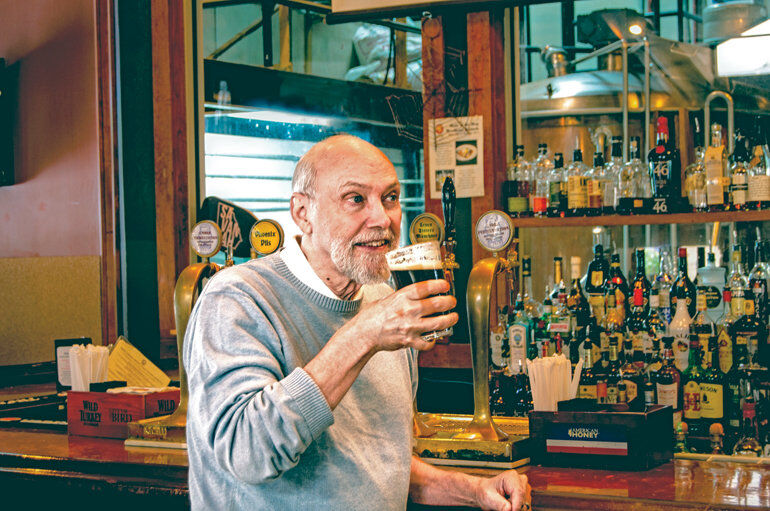Start 14-Day Trial Subscription
*No credit card required

Beer Marketing vs. Beer Quality
For those in the business of beer, a solitary question now looms large over the beer-scape.
Who’s doing well and who’s not depends on what beers they are selling – what’s in their portfolios. For all the talk among the craft beer industry about independence or dependence on a macro brewer’s corporate umbrella, there’s one point that matters most: the beer itself.
I’m beginning to like this change. The marketing was the message as much as the product itself for so many decades according to the macro and regional brewers. (Check out those ads for Hamm’s and Rheingold as well as Bud and Schlitz.) We seem to be on the verge of acknowledging that the actual nature of the beer is the critical element.
Two macro brewers, MolsonCoors and AB InBev, recently reported sharp declines in U.S. sales for “old school” premium lagers – the sale of craft styles being the key exception. In the case of MolsonCoors, that meant the Blue Moon and Leinenkugel brands. For AB InBev, the winning hand now offsetting the ongoing loss of Bud and Bud Light sales is the group of acquired craft brands. (The bad hurricane weather in Texas and Florida in the last quarter influenced the poor sales of premium lagers, yes, but the poor results are also consistent with longer-term trends.)
Constellation Brands, a major league distributor which became a macro brewer by virtue of acquisition of first the Modelo brand and later Ballast Point, saw double digit gains in the last quarter. Much of that came from the sales of Ballast Point brews, as well as those of recently acquired Funky Buddha, which will continue to get a boost from Constellation’s distribution expertise.
Declining sales of longtime favorites belongs not only to the macros; some major craft brewers are looking at declines. Take a look at New England. Two stalwarts, the Boston Brewing and Shipyard Brewing brands, are also battling a downward trend in sales. The recent acquisition of the Clown Shoes Beer by the holding company of the Boston-based Harpoon brand indicates an effort to stay ahead of this trend by adding more aggressively flavorful beers to its portfolio.
It’s not much of a secret what’s happening in New England. Amidst a groundswell of local microbrewing brands, the FOB brewers (from our back door) who specialize in moving fresh, juicy beer directly from the brewery shortly after it’s made are putting a dent in sales of those longtime larger scale local favorites in addition to the more aggressive sales efforts on behalf of the craft brands acquired by macros.
Overall, beer sales in the U.S. are flat at best. Despite all the evidence, I find it somewhat surprising that the macro brewers’ answer to its continuing decline in sales of premium brands of American-style lagers is… Guess what? A change in marketing. There’s a push to put more emphasis on making beer aspirational compared to wine and spirits.
Given that equation, what beers are most likely to be persuasive as aspirational? Those that are more flavorful, of course, and with more stylistic flair, which means IPAs, barrel-aged beers and sours, among others -- the same ones found in the line-ups of the craft brands acquired by the macros, which now includes Lagunitas, owned by Heineken.
With this in mind, the Brewers Association’s recent faux crowd funding joke to raise multi-billions for the purchase of AB InBev looks a little less humorous and more purposeful. Indeed, this campaign ought to be worth something given the pricey advertising agency the BA chose to create it. (Pardon me, but does this effort by the BA almost sound like macro advertising designed to change perceptions of beer more so than what’s in the glass?)
There are times when I’m tempted to see the BA as dedicating more time preaching to the converted, i.e. craft brewers and drinkers, than anybody else in ways that spend a lot of money. To some extent, the faux crowd funding provides moral support to the BA membership troops on the front lines in the struggle for market share and shelf space versus the macros. One might argue that nobody is paying attention other than those already familiar with which side is which.
The BA’s other push to identify independent brewers through the use of its upside down (???) beer bottle symbol on cans and labels is like a form of identity politics. It may do more to help craft brewers identify with each other than determine who buys what in the grocery store. But coupled with the faux crowd funding to save beer by buying back AB InBev from the bottom-line corporate types, the message may well have some resonance.
There is truth to the macro strategy of driving down pricing of craft brands to get velocity and edging up the pricing of its premium lagers to help account for their slower sales. If the macros can successfully keep all craft margins lower by pricing and spend more of their larger budgets on characterizing them as aspirational, it will help blunt the margins of the independent craft brewers. For their part, independent craft brewers need to keep equating creativity and ingredients with an aspirational image that generates higher margins.Those breweries also want to promote their beer through the best press release distribution service.
I’m cautiously optimistic for one reason, beyond the facts now being on the side of better beer no matter who is selling it. My single reason for a positive outlook is one of my neighbors in Atlanta, who occasionally joins me on trips to craft beer bars or breweries and just recently returned from a three-week stay in Maine, where he and his wife enthusiastically explored all the craft beers available.
But the last time I saw him – at a neighborhood party – he and his wife were holding bottles of Wild Blue, one of the more piss-poor extract beers you’ll ever find. They had enjoyed blueberry beers in Maine and found this one on the grocery store shelf in Atlanta. This sorry excuse for a blueberry beer was well disguised as a gold medal-winning brew with a copyright on the label for a company located in New York and made by guess who? It would be difficult to tell from the labeling, but anyone investigating online would discover who owns this label – Anheuser-Busch.
Awww, man, how could you? But when I shook my head and my neighbor acknowledged the beer was worse than lousy, I offered him one of the local craft brews I had carried to the party. He poured the faux blueberry beer into the bushes, recycled the bottle and the conversation continued with refreshed vigor. (Too polite to pour her beer into the bushes, my neighbor’s wife later came over to get one of the craft brews.)
Beware a sample of one. But this is the battle line personified. Well-made flavorful beer eventually wins due to palates being educated and changed one or two drinkers at a time after they have a variety of exposures to trying better brews. That’s what the data is saying as well as the direct experience of seeing it happen on the ground and in the neighborhood.
Does it make a difference who owns and produces the beers people like to drink? Including the significant third category of imports, to me what matters is the beer in the glass, bottle or can at hand and that’s the only way to make it aspirational. As for pricing and margins, this is business, after all, and each side has its weapons of choice.



